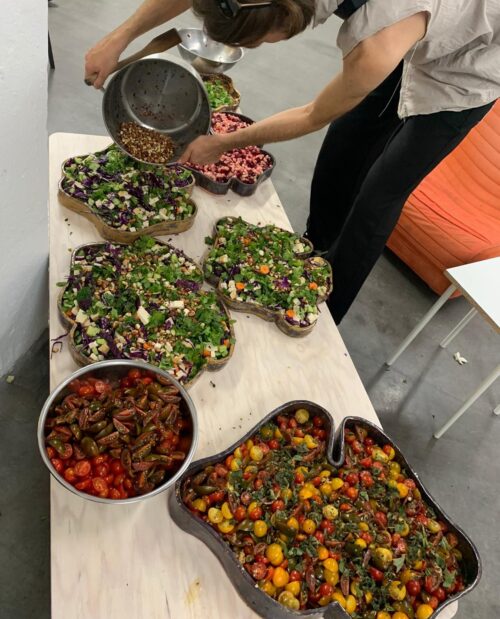
Opening remarks: [Pass around fresh basil leaves.] Everyone is invited to put one of these basil leaves under their tongues, if they want to. This is a cue taken from the medieval mystic Hildegard of Bingen, who wrote a lot about herbs, and who suggested basil for loosening the tongue (“place basil under the tongue, and speech will return”). Let the basil leaf feel like a second tongue. This is an invitation to start thinking about becoming many-tongued together, through herbal prosthesis and botanical extension …
The salads on tonight’s menu all contain herbal encouragements for rumourous and gossipy exchange. While working on the recipes I asked some friends for advice. The apple salad has cinnamon, which my friend Deborah suggested as a social inducer which is both warming and outward-moving in its atmospheric effects. The mezcal cocktails have ginger, lemon, agave, fennel, and a very special ingredient: acmella oleracea (also known as buzz buttons, ting flowers, and electric daisies). My friend Annick suggested these yellow flowers; they produce an intense sensation in the mouth, a kind of numbing and fizzing effect, which then leaves the tongue open to sensation and flavour. They also have the effect of producing a lot of saliva, which lubricates the flow of gossip… Annick and I also talked about sage, which is generally good for the respiratory system, the lungs, the throat chakra, the mouth and the tongue, it’s good for breath and speech and song … The tomato salad has a lot of fresh sage in it. There’s also a Thai herb salad, which is full of basil, painted full of tongues, like all of us. Enter Rumor, painted full of tongues: This is a stage direction from Shakespeare’s Henry IV, and it’s the title of the talk I’ll be giving later this evening. But first, let’s eat …


Enter RUMOUR, painted full of tongues was a dinner I hosted as part of K2020 at Lothringer 13 Halle, Munich. Some documentation from the makeshift kitchen ^^^ Ceramics and tables by artist Achinoam Alon – ceramics modelled after cross-sections from neurological representations of nervous pathways in the body.
This event was to Grapevine Epistemologies, a project which looks at gossip, rumor, and hearsay as queer-feminist epistemologies. To hear something through the grapevine is to receive it through dispersed social channels that are akin to the sprawled tangles of tendrils and vines. This expression, which has its origins in the talk that travelled informally among laborers of plantation economies, stands in contrast to the idea of communication as a clean, linear transmission with traceable origins. I am working on a book that asks what happens when indirection, speculation, fantasy, incompleteness, and doubt register in the historical record, and within the mechanics of its constitution. The project considers the possibilities and thresholds of gossip as a social practice, an artistic medium, a political tool, a historical force, and a research methodology.